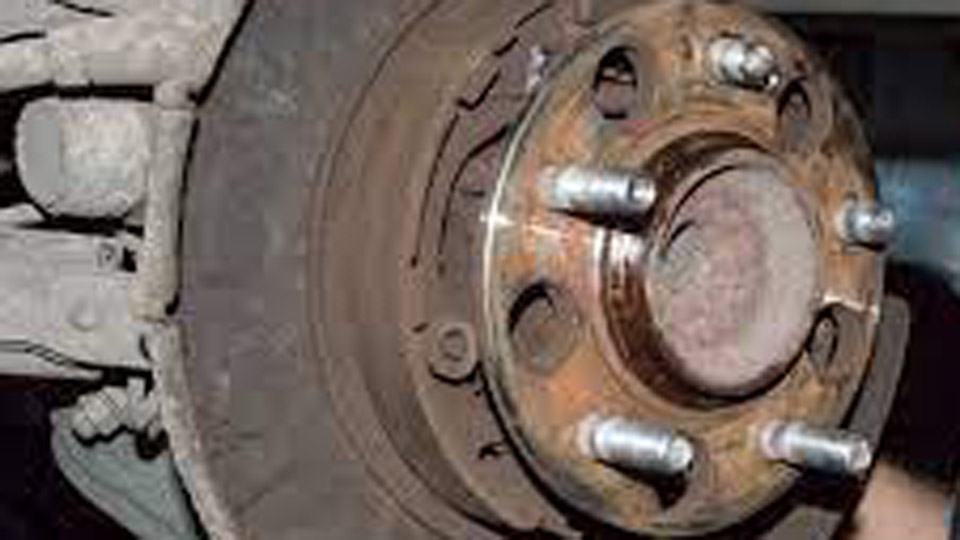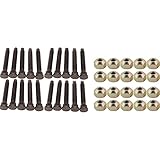How to Replace Wheel Studs on Disc Brakes?
Imagine you’re swapping a tire on your car, and as you tighten the lug nut, snap—a wheel stud breaks. That’s exactly what happened to me on my 2005 Chevy Silverado during a routine tire rotation. I was frustrated, but I figured out how to replace the wheel stud myself, and it wasn’t as tough as I thought. Wheel studs are those metal bolts that hold your wheel to the hub, and they can break from overtightening, rust, or just wear and tear.
Replacing them on a car with disc brakes is a job most folks can handle with some basic tools and patience. I’ve done it on my truck and a friend’s Honda Civic, and I’m here to share the steps, tricks, and tools you need to get it done. Whether you’re a DIY newbie or a seasoned wrench-turner, this guide will help you replace wheel studs.

Photo by autonationmobileservice
What Are Wheel Studs and Why Do They Break?
Wheel studs are the threaded bolts pressed into the wheel hub or rotor. Lug nuts screw onto them to secure the wheel. In cars with disc brakes, the studs are usually part of the hub or rotor assembly. They take a lot of stress—holding the wheel tight through every turn, bump, and brake. I learned this when I noticed my truck’s studs were rusted after years of salty Minnesota winters.
Studs break for a few reasons, based on what I’ve seen:
- Overtightening: Using an impact wrench without a torque wrench can snap studs. I’ve been guilty of this in a rush.
- Corrosion: Rust weakens studs, especially in snowy areas. My Chevy’s studs were rusty, making one brittle.
- Fatigue: Constant stress from driving wears them out. Older cars, like my truck, are prone to this.
- Cross-Threading: If a lug nut is misaligned, it can damage the stud’s threads. I saw this on a friend’s Civic.
- Impact Damage: Hitting a pothole or curb can weaken studs. A buddy’s Ford had this issue after a rough road.
A broken stud means you can’t secure the wheel properly, which is dangerous. Even one bad stud needs replacing, but I often swap all on a wheel to prevent future issues.
Tools and Materials You’ll Need
Before you start, gather the right tools. I made the mistake of diving into my Chevy’s repair with just a hammer and ended up stuck. Here’s what I use now:
- Lug Wrench or Socket: To remove lug nuts. I use a 19mm socket for my Chevy.
- Jack and Jack Stands: To lift and secure the car. I got a $50 jack at an auto store.
- Hammer: A 3-pound sledgehammer works for knocking out studs. I borrowed one from a neighbor.
- Wheel Stud Puller or Lug Nut Trick: To pull the stud out. I’ll explain the lug nut trick later.
- Replacement Wheel Studs: Match your car’s size and thread. I paid $5 each for Chevy studs.
- Lug Nuts: Extras for the repair process. I keep spares in my toolbox.
- Torque Wrench: To tighten lug nuts properly. My $40 torque wrench is a lifesaver.
- Wire Brush or Sandpaper: To clean rust from the hub. I use a $2 wire brush.
- Lubricant: WD-40 or anti-seize for stuck studs. I use WD-40 Specialist.
- Socket Wrench: For rotor or caliper bolts. A 10mm or 12mm socket usually works.
- Optional: Impact wrench, punch, and safety glasses. I wear glasses to protect my eyes from flying metal.
Having these ready saves time. I keep a tool bag in my garage for jobs like this.
Step-by-Step Guide to Replacing Wheel Studs
Replacing wheel studs on disc brakes takes about an hour per wheel once you get the hang of it. I’ve done it a few times, and here’s the process I follow, based on my Chevy repair:
Step 1: Prepare the Car
Park on a flat surface and engage the parking brake. Loosen the lug nuts on the affected wheel, but don’t remove them yet. I use a lug wrench and put my weight into it. Jack up the car, secure it with jack stands, and remove the wheel. I always double-check the stands to make sure the car’s stable.
Step 2: Remove the Brake Components
With disc brakes, you need to access the hub or rotor. Start by removing the brake caliper. I unbolt it (usually two bolts) with a socket wrench and hang it with a bungee cord to avoid stressing the brake line. Next, remove the caliper bracket if needed—mine had two more bolts. Then, pull off the rotor. If it’s stuck, tap it with a hammer. My Chevy’s rotor was rusted on, so I sprayed WD-40 and tapped gently.
Some cars, like my friend’s Civic, have the studs in the hub, not the rotor. In that case, you might not need to remove the rotor—just check if there’s enough clearance to pull the stud.
Step 3: Remove the Broken Stud
Find the broken stud. If it’s snapped, the lug nut might still be on—remove it with a socket. To get the stud out, you need to push it through the back of the hub or rotor. I use the lug nut trick: place a stack of washers or a deep socket over the stud’s head (on the back side), screw on a lug nut, and tighten it to pull the stud out. It took me 10 minutes of steady turning to pop the stud free on my Chevy.
If you have a stud puller tool ($15–$30), it’s faster. Hammering the stud out works too, but be careful not to damage the hub. I tried hammering first but switched to the lug nut trick for better control.
Step 4: Clean the Hub or Rotor
Before installing the new stud, clean the stud hole with a wire brush or sandpaper. Rust or debris can make it hard to insert the new stud. I spent 5 minutes scrubbing my Chevy’s hub to make it smooth. Spray a little WD-40 to ease the new stud in.
Step 5: Install the New Stud
Insert the new stud into the hole, threaded end first, from the back of the hub or rotor. Make sure it’s aligned straight. To pull it into place, I use the lug nut trick again: place a washer or spacer over the stud, screw on a lug nut, and tighten until the stud’s head is flush with the hub. I had to crank hard to seat the stud fully, but it worked like a charm.
Some folks use a hammer to tap the stud in, but I avoid this—it can damage the threads. Check that the stud is fully seated and doesn’t wobble.
Step 6: Reassemble the Brake Components
Put the rotor back on if you removed it. I align it carefully to avoid wobbling. Reattach the caliper bracket and torque the bolts to your car’s specs (usually 80–100 ft-lbs). Then, hang the caliper back in place and bolt it down. I double-check all bolts to make sure they’re tight.
Step 7: Mount the Wheel
Put the wheel back on and hand-tighten the lug nuts. Lower the car off the jack stands, then use a torque wrench to tighten the nuts to your car’s specs (usually 80–100 ft-lbs for most cars). I torque in a star pattern to keep the wheel even. My Chevy’s manual says 100 ft-lbs, so I stick to that.
Step 8: Test the Repair
Drive the car slowly in a safe area, like your driveway, to check for noises or vibrations. I took my truck around the block to make sure the wheel was secure. Retorque the lug nuts after 50–100 miles to be safe.
This job took me about 90 minutes the first time, but I’ve gotten it down to 45 minutes with practice.
Common Problems and Fixes
I’ve hit a few snags replacing wheel studs. Here’s what to watch for, based on my repairs:
- Stuck Rotor: Rust can glue the rotor to the hub. I spray WD-40, wait 5 minutes, and tap with a hammer to free it.
- Damaged Hub: If the stud hole is worn or stripped, you may need a new hub ($50–$200). I haven’t had this, but a buddy did on his Ford.
- Stripped Threads: If the new stud’s threads are damaged, get another. I keep extras in case one’s a dud.
- Tight Fit: Some hubs have tight stud holes. I sand lightly and use WD-40 to ease the stud in.
- Caliper Won’t Budge: Rusted bolts can be tough. I soak them in WD-40 and use a breaker bar for extra leverage.
If you’re stuck, take a break and recheck your steps. Patience is key.
Costs of Replacing Wheel Studs
This is a budget-friendly repair if you do it yourself. Here’s a table of typical costs based on my experience:
| Item | Estimated Cost (USD) |
|---|---|
| Wheel Studs (per stud) | $3–$10 |
| Lug Nuts (if needed) | $1–$5 each |
| Stud Puller Tool | $15–$30 |
| WD-40 or Anti-Seize | $5–$10 |
| Wire Brush | $2–$5 |
| Mechanic Labor (if needed) | $100–$300 |
I spent $15 on studs and $5 on WD-40 for my Chevy, doing it myself. A shop quoted me $200, so DIY saved me a lot. Costs vary by car—luxury models have pricier parts.
Tips for a Successful Repair
Here’s what I’ve learned to make the job smoother:
- Buy Extra Studs: Get one or two more than you need. I had a stud with bad threads and was glad for a spare.
- Use a Torque Wrench: Overtightening lug nuts can break another stud. I always torque to spec.
- Work on a Flat Surface: A level driveway prevents the car from shifting. I learned this after a jack slipped on a slope.
- Take Pictures: Snap photos of the brake setup to remember how it goes back. This saved me on my Civic repair.
- Clean as You Go: Wipe down the hub and rotor to prevent rust. I use a rag and brake cleaner.
Preventing Wheel Stud Issues
I’ve found ways to keep studs from breaking again:
- Torque Properly: Always use a torque wrench for lug nuts. I check my Chevy’s manual for the right ft-lbs.
- Clean Rust: Brush off rust from studs and hubs yearly, especially in snowy areas. I do this during tire rotations.
- Avoid Impact Wrenches: They can overtighten and stress studs. I stick to hand tools for final tightening.
- Check Studs Regularly: Look for cracks or rust when changing tires. I caught a weak stud early this way.
- Use Anti-Seize: A dab on new studs prevents rust and makes future removal easier. I started doing this after my repair.
These habits have kept my truck’s studs solid for years.
When to Call a Professional
I love DIY, but some stud repairs are tricky. If you see these, consider a mechanic:
- Damaged Hub: A worn or stripped hub needs special tools to replace. I sent a friend’s Ford to a shop for this.
- Seized Rotor: If the rotor won’t budge, a pro can handle it without damage. I’ve seen this on rusted older cars.
- Multiple Broken Studs: If several studs are snapped, there might be a bigger issue. A mechanic can diagnose it.
- No Tools or Time: If you lack a torque wrench or jack stands, a shop is safer. Expect to pay $100–$300.
I’ve done most of my stud replacements myself, but I’ve used a mechanic when I was short on time.
My Experience Replacing Wheel Studs
Fixing the wheel stud on my Chevy was a learning experience. The first time, I struggled to get the rotor off—it was rusted tight. I sprayed WD-40, tapped it loose, and used the lug nut trick to swap the stud. It took two hours, mostly because I was figuring it out.
I’ve replaced studs on a Honda Civic and a Toyota Corolla for friends, each time faster. The job cost me $20 in parts, compared to a $200 shop quote. The best part? Knowing my wheels are secure and I didn’t overpay.
Why Replacing Wheel Studs Matters
A broken wheel stud isn’t just a nuisance—it’s a safety issue. If you can’t secure the wheel properly, it could wobble or come off while driving. I worried about this when my Chevy’s stud snapped, especially on the highway. Fixing it restores safety and peace of mind, plus it keeps your car looking professional. A missing stud is a red flag for mechanics or buyers, so it’s worth the effort to fix.
Conclusion
Replacing wheel studs on disc brakes might seem daunting, but it’s a job you can tackle with some basic tools and a little grit. From my own garage battles, I’ve learned that a snapped stud is usually a quick fix—pop out the old one, pull in a new one, and torque it right.
Whether it’s rust, overtightening, or just age, you can save money and feel like a hero by doing it yourself. Grab a hammer, a torque wrench, and a few studs, and get your wheels spinning safely again. There’s nothing like the satisfaction of a job well done and a car that’s ready for the road.
Frequently Asked Questions
How do I know if my wheel stud is broken?
If a stud is snapped, cracked, or has damaged threads, or if the lug nut won’t tighten, it’s broken and needs replacing.
Can I replace wheel studs myself?
Yes, with tools like a jack, hammer, torque wrench, and replacement studs, most people can do it in 1–2 hours.
How much does it cost to replace wheel studs?
DIY costs $10–$50 for parts. A mechanic charges $100–$300, including labor.
What tools do I need to replace wheel studs?
You’ll need a jack, jack stands, lug wrench, hammer, torque wrench, wire brush, WD-40, and replacement studs.
Can I drive with a broken wheel stud?
It’s risky. One broken stud weakens the wheel’s hold. Replace it ASAP and don’t drive far.
How long do wheel studs last?
Studs can last the life of the car, but rust, overtightening, or impact can cause them to fail sooner.
Should I replace all wheel studs at once?
Only if they’re all damaged or rusted. I replace one or two unless the others show wear.

David Peterson, the chief editor of sparepartscare. I am an automobile engineer and assign to an local firm with much experience in automobile equipment. During the time, most of my experience is related to the Industry of cars parts. I learned about the thing, when working with experienced inspectors, one must be as good as the inspector, or better, with knowledge of the project as well as the practical aspects of automobile industry.












